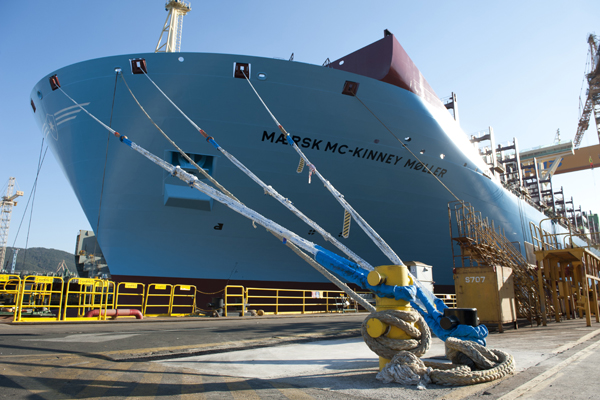Maersk makes waves with massive container vessels
Updated: 2013-07-20 01:59
By ZHONG NAN (China Daily)
|
|||||||||||
Twenty Triple-E vessels ordered to deploy on Asia-Europe route
Maersk Line has deployed the world's largest container ship on its China services to serve the nation's growth in foreign trade.
The first of the series of Triple-E vessels owned by Maersk Line, the shipping unit of Denmark's AP-Moller Maersk shipping and oil conglomerate, made its maiden call at the Shanghai Yangshan port on Friday.
 |
|
Triple-E, the largest container ship designed to carry 18,000 TEUs, is constructed at the port of Okto in South Korea in June. This is the first of the series ordered by Maersk Line, the shipping unit of Denmark’s AP-Moller Maersk shipping and oil conglomerate. Provided to China Daily |
The new ship is the first of the 20 Triple-E vessels ordered by the Danish shipping giant and built by Daewoo Shipbuilding and Marine Engineering Co Ltd in South Korea. Each vessel will cost $185 million.
The Triple-E vessels are designed to carry 18,000 20-foot equivalent units. The ship, which is 400 meters long and 59 meters wide, is the largest vessel of any type on the water now. However, it only requires 22 crew members.
David Williams, managing director of Maersk Line East and Central China, said the Triple-E fleet will help position the cargo carrier to meet China's growth in foreign trade. It is the most efficient way for Maersk Line to tap into the development of China, he said.
Another five Triple-E vessels will be delivered to Maersk Line by December, and they will be deployed on the Asia-Europe route. The remaining 14 ships will be delivered by 2015. The expected service life of each vessel is 25 to 30 years.
Williams said Europe and the United States are certainly having difficulties in resolving different financial problems.
"We are still facing challenges because China's exports are largely based on these countries' demand for Chinese goods," he said.
"The Triple-E vessels feature innovative technology, leading to energy efficiency and environmental performance.
"The unprecedented dimensions provide economies of scale, while the unique design features enable the vessel to emit 50 percent less carbon dioxide per container moved than the current average on the Asia-Europe route," said Williams.
In 1968, Maersk Line had just a single non-containerized service connecting Asia and Europe, which consisted of 12 sailings a year. Now, its vessels call at all major ports in China, offering a wide range of weekly sailings to all parts of the world.
About two-thirds of its cargo on the Asia-Europe service go to or from China.
Chen Xuyuan, the chairman of Shanghai International Port Group, said the Port of Shanghai, the world's largest by throughput, has the facilities and experience to serve this new vessel.
"Large Chinese ports are proficient in receiving and loading container goods, thus they are capable of handling large-scale ships," Chen said.
"From a long-term perspective, we will benefit from the efficiency and environmental features of the new vessels to further strengthen our port capacity to ship more Chinese products to major markets in Europe."
Deployed on the Asia-Europe route, the Triple-E vessel will touch four Chinese ports in the loop: Shanghai, Ningbo, Yantian and Hong Kong. However, Maersk's move is accompanied by concerns about the prospects for declining global trade, including the question of whether China's exports can remain stable, as foreign orders for its goods have dropped amid prolonged global weakness.
"Maersk has the largest market share of any container shipping line on the Asia-Europe route, moving 20 percent of the container cargo from Asia to Europe and 18 percent in the opposite direction.
"It makes up one-quarter of Maersk Line's business; therefore, we put the new vessel on this route," said Brian Kristensen, vice-president of the Far East Asia liner operations cluster for Maersk Line.
Han Yichao, an industrial analyst with Changjiang Securities Co, said super-sized container ships mean lower freight rates and more business opportunities.
Han said that fuel-guzzling, high-maintenance container ships are no longer required for maritime transportation, where competition is vicious.
"Large container ships are more likely to dominate the developing trends of the global shipping business," said Han.
Today's Top News
Qinghai monks preaching the dangers of TB
Family of dead baby waits for autopsy
China pushes environment forward
Asiana legal fallout begins after deadly crash
Maersk makes waves with container vessels
Floor on lending rates axed by PBOC
Tokyo's 'big leap' aimed at China
China's government spends less in 2012
Hot Topics
Lunar probe , China growth forecasts, Emission rules get tougher, China seen through 'colored lens', International board,
Editor's Picks

|

|

|

|

|

|





